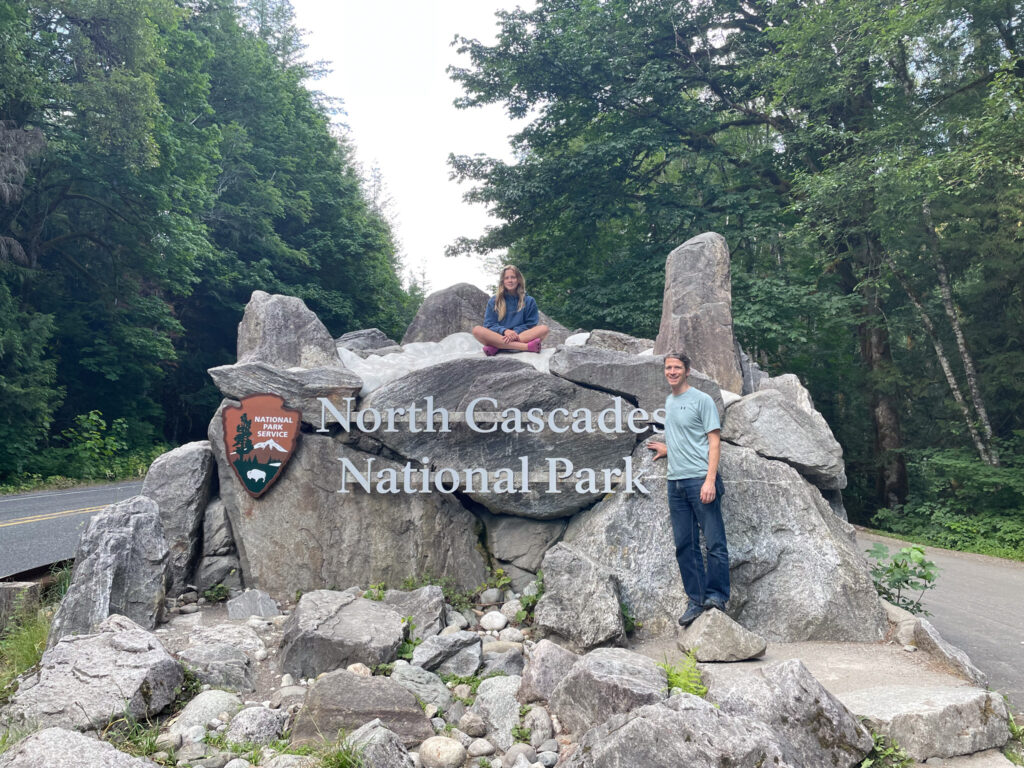
COMPLETE GUIDE TO NORTH CASCADES NATIONAL PARK
Located in Northern Washington State, this remote and rugged National Park is a pristine haven of natural beauty and outdoor adventure. Defined by its towering peaks, including the iconic Mount Shuksan and Mount Baker, the park is full of of alpine meadows, dense forests, and turquoise glacial lakes like Diablo Lake and Ross Lake.
A paradise for hikers, the park offers an extensive network of trails, including portions of the Pacific Crest Trail, leading to breathtaking viewpoints and high mountain passes. This is one of our favorite National Parks and one that is worth visiting again and again. In this article we’ll explore what you need to know for visiting North Cascades National Park.
Highlights of Visiting North Cascades National Park
Below are some of the highlights of visiting North Cascades National Park
Scenic Beauty: North Cascades is known for its breathtaking landscapes, including towering peaks, alpine meadows, dense forests, and pristine lakes. The park is popular for photographers and nature lovers seeking diverse and picturesque scenery.
Hiking Trails: There are numerous hiking trails catering to various skill levels. Trails like the Cascade Pass Trail and Maple Pass Loop offer stunning views of the surrounding mountains and valleys. The Pacific Crest Trail also passes through the park, providing long-distance hiking opportunities.
Mountain Peaks: The park is home to some of the most iconic peaks in the Cascade Range, including Mount Shuksan and Mount Baker. These glaciated peaks attract climbers and offer challenging ascents for those seeking a mountaineering adventure.
Wildlife Viewing: North Cascades is rich in biodiversity, and visitors have the chance to spot a variety of wildlife, including black bears, mountain goats, marmots, deer, and a variety of bird species. Don’t forget your binoculars!
Boating and Fishing: Diablo Lake and Ross Lake are popular for boating and fishing. The vibrant turquoise color of Diablo Lake, caused by glacial runoff, is a particularly striking sight. Anglers can try their luck at catching various species of fish.
Camping: The park offers several campgrounds -backcountry camping is also available for those looking for a more secluded experience.
Educational Programs: The park offers educational programs and ranger-led activities that provide insights into the natural and cultural history of the area. Check with the park’s visitor center for scheduled programs.
Things to Know About Visiting North Cascades National Park
While North Cascades is a stunning National Park – there are a few important things to know to help you plan your visit.
Best Time to Visit North Cascades National Park
The best time to visit North Cascades National Park depends on your preferences and the activities you have in mind. Summer, from June to September, is the most popular time when the park is alive with vibrant wildflowers, and the majority of hiking trails are accessible. The weather is generally mild, and the turquoise glacial lakes, such as Diablo Lake, are particularly stunning.
Autumn, from late September to October, brings a breathtaking display of fall colors, transforming the landscape into a tapestry of reds, yellows, and oranges. Winter and spring will have some closed roads due to snow.

How to Get to North Cascades
If you’re flying, the closest major airports are Seattle-Tacoma International Airport (SEA) or Vancouver International Airport (YVR) in Canada. From either airport, you can rent a car to reach the park. This park is best explored by car.
If you’re driving from Seattle, take Interstate 5 North to State Route 20 East. The park is accessible via the North Cascades Highway, known for its scenic beauty. Keep in mind that the park has multiple entrances, so plan your route based on your desired destination within the park.
Once in the park, be prepared for winding mountain roads and check for any road closures or conditions, especially in winter. Remember to use a navigation system or map, and enjoy the picturesque journey to North Cascades National Park.
Need to Know About North Cascades
- Diverse Terrain and Peaks: North Cascades National Park is renowned for its diverse and rugged terrain. The park encompasses towering mountain peaks, including iconic ones like Mount Shuksan and Mount Baker. Glacially carved valleys, dense forests, alpine meadows, and pristine lakes contribute to the park’s stunning and varied landscapes.
- Abundant Outdoor Activities: Hiking trails cater to various skill levels, wildlife viewing opportunities abound, and winter brings opportunities for snowshoeing and cross-country skiing.
- Remote and Secluded: North Cascades is known for its remote and less-visited status compared to other national parks. Be prepared when heading out into the park.
- Weather Variability: The weather in North Cascades National Park can vary significantly depending on the season and elevation. Summers are generally mild, but sudden weather changes are common.
- Limited Services and Amenities: The park has limited services and amenities, compared to more developed national parks. While there are visitor centers, campgrounds, and some facilities, visitors should be self-sufficient, carrying essentials like water, food, and appropriate gear. Cell phone reception may be unreliable in certain areas, so it’s advisable to plan ahead and be prepared for a more rustic experience.

How Much Time do you Need in North Cascades National Park?
This depends on how you plan to spend your time in the park. At a minimum you need at least 2 full days to do a few of the hikes. Many people who explore the North Cascades spend more time in the park and hike or camp into the backcountry.
Lodging Near North Cascades National Park
There are several campgrounds in the park that can be booked in advance. Otherwise you can stay in one of the nearby towns. No matter which option you choose it’s best to book lodging well in advance.
Winthrop: This western-themed town is located on the eastern side of the park and offers a range of accommodations, including cozy inns, cabins, and lodges.
Twisp: Another nearby town, Twisp, provides a variety of lodging options, including bed and breakfasts, cabins, and motels.
Marblemount: Situated on the western side of the park, Marblemount is close to the park’s visitor center and is a gateway to many hiking trails. There are a few lodging options, including motels and cabins, providing easy access to the park’s western attractions.
Concrete: This town is located south of the park and offers a few accommodation choices, including motels.
Sedro-Woolley: Positioned to the southwest of the park, Sedro-Woolley provides additional lodging options, including hotels and inns.

